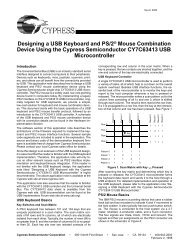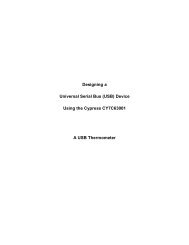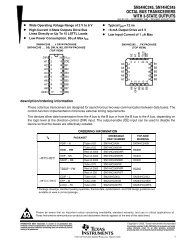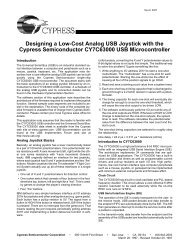Designing a Low-Cost USB Mouse with the Cypress Semiconductor ...
Designing a Low-Cost USB Mouse with the Cypress Semiconductor ...
Designing a Low-Cost USB Mouse with the Cypress Semiconductor ...
Create successful ePaper yourself
Turn your PDF publications into a flip-book with our unique Google optimized e-Paper software.
<strong>Designing</strong> a <strong>Low</strong>-<strong>Cost</strong> <strong>USB</strong> <strong>Mouse</strong><br />
The Port Pull-up Registers are located at I/O address 0x08<br />
and 0x09 for Port 0 and Port 1 respectively. The Data Registers<br />
are located at I/O address 0x00 and 0x01 for Port 0 and<br />
Port 1 respectively. The Port 0 and Port 1 Interrupt Enable<br />
Registers are at addresses 0x04 and 0x05 respectively.<br />
Wake-Up Interrupt<br />
Power management is paramount in many <strong>USB</strong> applications.<br />
To conserve power, <strong>the</strong> CY7C63000 supports an externally<br />
programmable interrupt input to wake up <strong>the</strong> microcontroller<br />
from <strong>the</strong> suspend mode when <strong>the</strong> mouse is moved or when a<br />
button is pressed. The suspend mode causes <strong>the</strong> microcontroller<br />
to shut down most of its functions such as <strong>the</strong> clock<br />
circuit, <strong>the</strong> RISC core, <strong>the</strong> timer, and part of <strong>the</strong> SIE. In <strong>the</strong><br />
mouse application, a high percentage of <strong>the</strong> power is consumed<br />
by <strong>the</strong> LEDs. Therefore, <strong>the</strong> CY7C63000 should be<br />
programmed to turn off <strong>the</strong> LEDs before entering <strong>the</strong> suspend<br />
mode. With <strong>the</strong> LEDs off, <strong>the</strong> CY7C63000 can no longer detect<br />
any mouse movements although button closures are still<br />
recognized (because pressing a button causes an interrupt).<br />
This problem can be solved by using <strong>the</strong> wake-up interrupt<br />
that wakes up <strong>the</strong> microcontroller, checks for mouse movement,<br />
and <strong>the</strong>n goes back to suspend mode.<br />
The wake-up interrupt can be implemented by connecting <strong>the</strong><br />
CEXT pin to VCC <strong>with</strong> a resistor and to GND <strong>with</strong> a capacitor.<br />
Before <strong>the</strong> firmware puts <strong>the</strong> microcontroller into <strong>the</strong> suspend<br />
mode, it writes a zero to <strong>the</strong> Cext register at address 0x22 to<br />
discharge <strong>the</strong> external capacitor. Then, to start timing a one<br />
is written to <strong>the</strong> Cext register to allow <strong>the</strong> RC circuit to begin<br />
charging. A wake-up interrupt is generated to <strong>the</strong> RISC core<br />
when <strong>the</strong> external capacitor is charged up to nominal 2.75V<br />
(45% to 65% of Vcc) by <strong>the</strong> external resistor. The duration<br />
between successive wake-ups is controlled by <strong>the</strong> RC constant<br />
of <strong>the</strong> external resistor and capacitor.<br />
Hardware Implementation<br />
Figure 6 is <strong>the</strong> schematic for a mouse application.<br />
Photo transistor pins of Port 0 are programmed by writing a<br />
zero to <strong>the</strong> Data Registers which drives <strong>the</strong> output low. Then<br />
set <strong>the</strong> value of <strong>the</strong> Port Isink Register to <strong>the</strong> sink current<br />
value. One of sixteen sink current values could be selected.<br />
This is done to bias <strong>the</strong> photo transistors for correct operation.<br />
Button pins of Port 0 are programmed to accept active-low<br />
inputs <strong>with</strong> internal pull-up resistors enabled. This is accomplished<br />
by setting all bits in <strong>the</strong> Port 0 Data Register to “1” and<br />
setting <strong>the</strong> contents of <strong>the</strong> Port 0 Pull-up Register to all “0”s.<br />
Bits 4 to 6 of Port 0 are connected to <strong>the</strong> left, right, and middle<br />
buttons respectively. Bits 0 and 1 are connected to <strong>the</strong> left and<br />
right photo transistors of <strong>the</strong> horizontal axis respectively. Bits<br />
2 and 3 are connected to left and right photo transistors of <strong>the</strong><br />
vertical axis respectively.<br />
The two LEDs are connected in series to bit 0 of Port 1. The<br />
LEDs are turned off in <strong>the</strong> suspend mode to conserve power.<br />
The LEDs are switched on only when <strong>the</strong> mouse wakes up.<br />
Because <strong>the</strong> sink current of each GPIO line can be set to one<br />
of sixteen levels, <strong>the</strong> user can adjust <strong>the</strong> light output of <strong>the</strong><br />
LEDs to match <strong>the</strong> sensitivity of a wide range of photo transistors.<br />
The CEXT pin of <strong>the</strong> CY7C63000 is connected to an external<br />
RC timing circuit formed by R2 and C1. The wake-up time is<br />
set to about 20 msec to achieve a good balance between<br />
wake-up response time and power savings.<br />
A 6 MHz ceramic resonator is connected to <strong>the</strong> clock inputs<br />
of <strong>the</strong> microcontroller. This component should be placed as<br />
close to <strong>the</strong> microcontroller as possible.<br />
According to <strong>the</strong> <strong>USB</strong> specification, <strong>the</strong> <strong>USB</strong> D– line of a<br />
low-speed device (1.5 Mbps) should be tied to a voltage<br />
source between 3.0V and 3.6V <strong>with</strong> a 1.5K ohms pull-up terminator.<br />
The CY7C63000 eliminates <strong>the</strong> need for a 3.3V regulator<br />
by specifying a 7.5 Kohm resistor connected between<br />
<strong>the</strong> <strong>USB</strong> D– line and <strong>the</strong> nominal 5V Vcc.<br />
3










